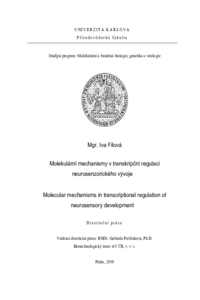Molekulární mechanismy v transkripční regulaci neurosenzorického vývoje
Molecular mechanisms in transcriptional regulation of neurosensory development
dizertační práce (OBHÁJENO)

Zobrazit/
Trvalý odkaz
http://hdl.handle.net/20.500.11956/116811Identifikátory
SIS: 135117
Kolekce
- Kvalifikační práce [21483]
Autor
Vedoucí práce
Oponent práce
Tureček, Rostislav
Valihrach, Lukáš
Fakulta / součást
Přírodovědecká fakulta
Obor
-
Katedra / ústav / klinika
Katedra genetiky a mikrobiologie
Datum obhajoby
7. 2. 2020
Nakladatel
Univerzita Karlova, Přírodovědecká fakultaJazyk
Čeština
Známka
Prospěl/a
Klíčová slova (česky)
ISL1, SOX2, NEUROD1, transkripční faktor, vývoj vnitřního ucha, sluchový a vestibulární systémKlíčová slova (anglicky)
ISL1, SOX2, NEUROD1, transcriptional factor, inner ear development, auditory and vestibular systemVývoj, maturace a životaschopnost neurosenzorických buněk vnitřního ucha je závislá na přesné časové a prostorové expresi transkripčních faktorů. Předmětem studia předkládané práce je objasnění funkce transkripčních faktorů ISL1, SOX2 a NEUROD1 v neurosenzorickém vývoji vnitřního ucha za použití tří myších modelů [Tg(Pax2-Isl1)], Sox2CKO a Neurod1CKO. Myší mutant [Tg(Pax2-Isl1)] má ve svém genomu transgenní sekvenci kódující gen Isl1, jehož exprese je řízena regulační sekvencí pro gen Pax2. Ektopická exprese ISL1 řízená regulační sekvencí Pax2 vedla ke zvětšení kochleovestibulárního ganglia a urychlený růst neuritů vnitřního ucha u embryí [Tg(Pax2-Isl1)]. V dospělosti u těchto mutantů docházelo k urychlené ztrátě sluchu v důsledku zhoršující se funkce vnějších vláskových buněk. Tyto změny korelovaly se ztrátou eferentních vláken z mediální olivy superior inervující vnější vláskové buňky. Poprvé jsme ukázali, že podstatou stařecké nedoslýchavosti (presbyakuze) kromě ztráty vláskových buněk a neuronů spirálního ganglia může být i poškození eferentní inervace. Kromě presbyakuze byly myši [Tg(Pax2-Isl1)] hyperaktivní. Po podání pikrotoxinu, blokátoru chloridových kanálů spjatých s GABA receptory, došlo u těchto mutantů k významnému potlačení hyperaktivity. Tyto analýzy ukázaly, že nadměrná a ektopická...
The development, maturation, and viability of inner ear neurosensory cells depend on the spatiotemporal expression of multiple transcriptional factors. Based on three mouse models [Tg(Pax2-Isl1)], Sox2CKO, and Neurod1CKO, this thesis investigates the function of three transcriptional factors ISL1, SOX2 and NEUROD1 in the neurosensory development of the inner ear. The mouse mutant [Tg(Pax2-Isl1)] carries transgenic sequence containing Isl1 gene under Pax2 regulatory sequence in its genome. ISL1 ectopic expression driven by Pax2 regulatory sequence resulted in the enlarged cochleovestibular ganglion and accelerated neurite extension in [Tg(Pax2- Isl1)] embryos. In adult mutants, we detected an early onset of age-related hearing loss correlating with the worsening function of outer hair cells. These changes were associated with the loss of medial olivocochlear efferent neuron fibers innervating outer hair cells. For the first time, we showed that the age-related hearing loss (presbyacusis) might be caused by efferent innervation defects besides hair cell loss and spiral ganglion degeneration. In addition to presbyacusis, [Tg(Pax2-Isl1)] mice suffered from hyperactivity that was diminished by the administration of picrotoxin - channel blocker for GABA receptor chloride channels. This indicates that...
